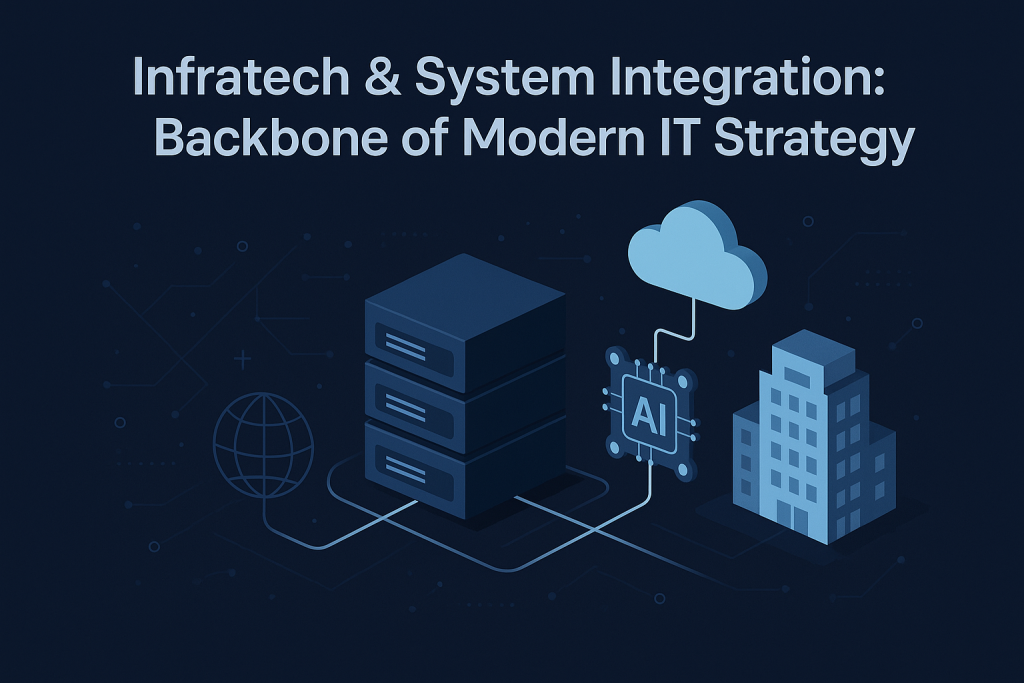
Infratech & System Integration: Backbone of Modern IT Strategy
Introduction: The Need for Future-Ready IT Infrastructures
In today’s fast-paced business world, companies are continually evolving and scaling to meet new demands. As enterprises move toward digital transformation, a robust and adaptable IT strategy is paramount. At the heart of this transformation lie Infratech and system integration, two key elements that enable organizations to leverage technology effectively.
Rather than simply implementing technologies, modern enterprises must ensure that their IT systems work together seamlessly. This is where Infratech—encompassing infrastructure technologies like hardware, cloud, and network solutions—and system integration play critical roles in aligning technology with business strategy.

Together, they form the foundation for a future-ready IT infrastructure capable of driving long-term growth and innovation.
Infratech: A Foundation for Scalable and Agile IT Infrastructure
Infratech encompasses all the core technological components needed to build an effective and scalable IT infrastructure. This includes hardware solutions, networking, cloud technologies, and data management systems. For businesses to grow, they need to deploy infrastructure solutions that offer both flexibility and the ability to scale according to demand.
Benefits of Infratech in Enterprise IT:
- Scalability and Flexibility: Modern cloud platforms (like AWS and Microsoft Azure) and hyperconverged infrastructure (HCI) solutions (from companies like Nutanix) provide the ability to scale up or down as the business demands. Enterprises can manage workloads dynamically, ensuring they can respond quickly to market changes.
- Security: As businesses face increasing cybersecurity threats, Infratech offers built-in security solutions, such as firewalls, encryption, and endpoint protection, that safeguard sensitive data.
- Data Optimization: With big data, AI, and analytics technologies, businesses can optimize their IT resources to ensure they are utilizing their data efficiently, driving insights that support business strategy.
System Integration: Creating a Cohesive IT Ecosystem
Once the foundational technologies are in place, it’s crucial to integrate these systems to create a seamless IT ecosystem. System integration connects disparate technologies—be it on-premises hardware, cloud-based services, or software applications—into a unified, coherent infrastructure that supports operational efficiency and growth.
Key Benefits of System Integration:
- Improved Operational Efficiency: By ensuring that different technologies and systems work together seamlessly, system integration streamlines business processes. Automation of manual tasks and the elimination of data silos lead to faster, more efficient operations.
- Real-Time Data and Insights: A well-integrated IT system ensures that data flows freely between applications, enabling real-time reporting and decision-making.
- Lower Total Cost of Ownership (TCO): System integration reduces the need for redundant technologies and manual interventions, lowering the overall cost of maintaining disparate systems and improving ROI.
How Infratech and System Integration Enable Future-Proof IT Strategies
For businesses to thrive in an ever-evolving landscape, their IT infrastructure must be agile and future-ready. That’s where the synergy between Infratech and system integration comes in.
Future-Readiness with Infratech:
- As organizations embrace AI, IoT, and 5G, their IT infrastructure must evolve to support these next-generation technologies. With cloud-native solutions, edge computing, and HCI, businesses can ensure they have a future-proof IT architecture that can easily incorporate emerging technologies.
Adaptability with System Integration:
- System integration ensures that businesses can adapt quickly to changing market conditions. As companies grow, they need systems that can evolve with them. Integrated IT systems allow for continuous improvement and innovation, helping enterprises stay competitive in the long run.
Enhancing Business Agility Through Integrated IT Systems
A modern enterprise IT strategy is more than just about implementing technologies—it’s about achieving business agility. With a strong system integration framework, businesses can respond to challenges more quickly and operate at a faster pace. Infratech solutions, like cloud and data center solutions, enable companies to keep up with the demand for innovation and the need for real-time, data-driven decisions.
System integration eliminates bottlenecks by ensuring that applications, processes, and technologies work together effortlessly, which allows businesses to respond more effectively to market changes, customer demands, and competitive pressures.
Conclusion: Building the Backbone for Long-Term Success
At ConsultEdge Global, we help businesses build and integrate the right infrastructure to support their evolving needs. By combining Infratech solutions with expert system integration, we enable enterprises to create a solid foundation for growth. Our partnership with leading OEMs, such as Cisco, HPE, Lenovo, and VMware, ensures that your IT infrastructure is built on the most cutting-edge technologies available.
The synergy between Infratech and system integration ensures that your business can scale seamlessly, adapt to change, and optimize performance—helping you remain competitive and prepared for future challenges.



